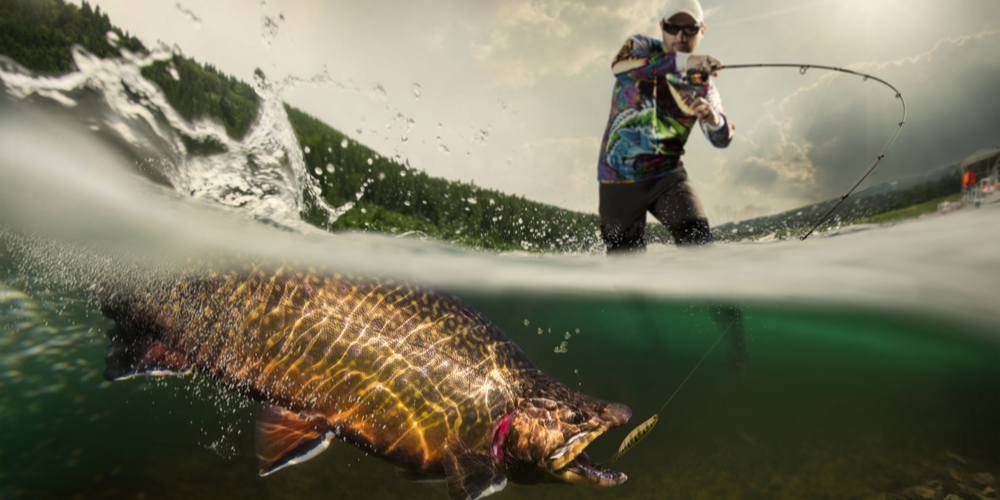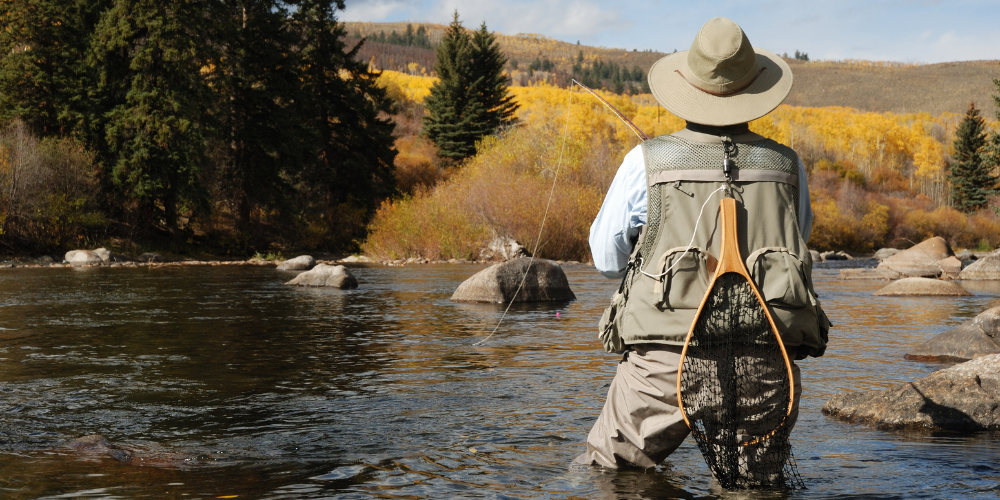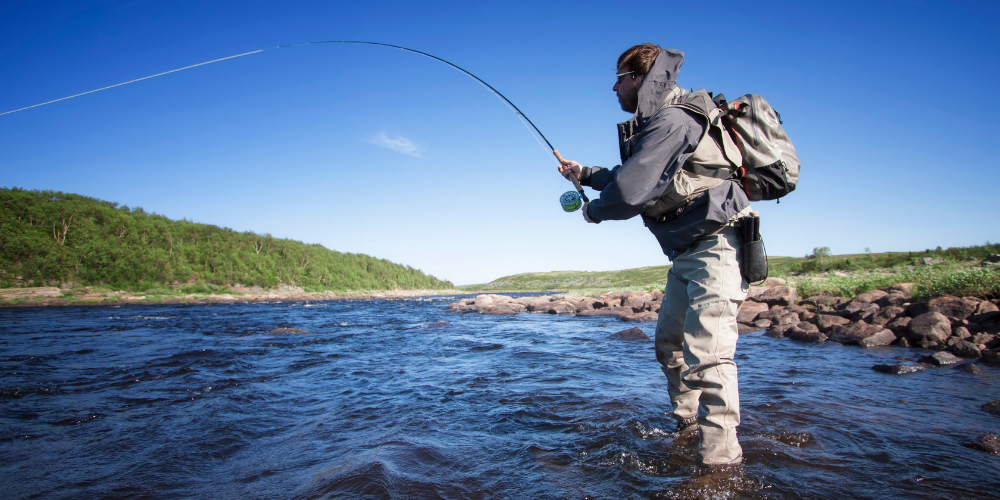Fly Fishing Tips: 10 Essential Guides for Success
In this fly fishing tips article, we present the top 10 tips to help you enhance your angling experience and increase your chances of landing that elusive catch. Fly fishing is a serene and captivating form of angling that requires skill, finesse, and a deep understanding of the water and its inhabitants. Whether you’re a beginner or an experienced angler, there are always ways to improve your fly fishing tips and techniques.

Choose the Right Equipment:
Investing in quality fly fishing tips equipment is crucial. Select a fly rod, reel, and line that are suitable for the type of fishing you plan to do. Seek advice from experienced anglers or knowledgeable professionals to ensure your gear matches your fishing style.
Understand the Water:
Before stepping into the river, take some time to observe the water. Study the current, depth, and structure of the river or stream. Pay attention to any signs of insect activity, as they provide valuable insights into what the fish are feeding on.
Learn Basic Casting Techniques:
Mastering fundamental casting techniques is essential for successful fly fishing. Practice your casting regularly to develop accuracy and precision. Focus on the basic casts like the overhead cast, roll cast, and reach cast, as they form the foundation of your fly fishing tips skills.
Match the Hatch:
Imitating the insects on which fish feed is crucial to fooling them into taking your fly. Learn to identify the prevalent insect species in your fishing area and carry a selection of fly patterns that imitate them. Matching the hatch increases your chances of enticing a strike.
Practice Stealth and Presentation:
Fish are easily spooked by sudden movements and noise. Practice stealth by moving slowly and keeping a low profile along the riverbank. Additionally, work on your presentation skills, delivering the fly softly and naturally to the fish. Avoid dragging the fly across the water, as it looks unnatural.
Study the Fish Behavior:
Understanding the behavior of the fish you are targeting can significantly improve your success rate. Learn about their feeding patterns, preferred habitats, and how they react to different weather conditions. This knowledge will help you position yourself effectively and choose the right fly.
Vary Your Retrieve:
Experiment with different retrieval techniques to entice the fish. Some days, a slow and steady retrieve is effective, while other times, a twitch-and-pause action might trigger a strike. Adjust your retrieve according to the fish’s behavior and the prevailing conditions.
Be Adaptable with Fly Selection:
Don’t get stuck using the same fly pattern all day long. Be willing to adapt and switch flies if you’re not getting any bites. Carry a variety of flies in different sizes, colors, and patterns to match the changing conditions and the fish’s preferences.
Practice Catch and Release:
Responsible angling involves treating the fish with care. Practice catch and release by handling the fish gently and minimizing their time out of the water. Use barbless hooks to reduce injury and increase the chances of survival when releasing the fish back into the water.
Learn from Experienced Anglers:
Never underestimate the power of learning from others. Join a fly fishing tips club or community, participate in workshops or guided trips, and engage with experienced anglers. Their knowledge and insights can be invaluable in honing your skills and expanding your understanding of fly fishing tips.
Diving Into Fly-Fishing: An Exciting Journey into the World of Angling
Fly-fishing is more than just a sport; it’s a passion, an art form, and a way to connect with nature. If you’ve always been intrigued by the idea of casting a delicate fly onto the water’s surface and enticing a trout to rise, then it’s time to dive in and explore the captivating world of fly-fishing. In this article, we’ll take you on a journey, introducing you to the fundamentals of fly-fishing and providing you with essential tips to get started. So grab your waders, tie on a fly, and let’s embark on an adventure that will undoubtedly hook you for life.

Understanding Fly-Fishing:
At its core, fly-fishing is a fishing method that utilizes an artificial fly to deceive fish into biting. Unlike conventional fishing, where the weight of the lure propels the line, fly-fishing relies on the weight of the fly line itself. The fly angler uses a specialized fly rod and reel to cast the fly, employing various casting techniques to present the fly naturally on the water’s surface or below it. Fly-fishing is renowned for its elegance and finesse, allowing anglers to engage with the environment and challenge themselves to outsmart elusive fish.
Gear Essentials:
To embark on your fly-fishing journey, you’ll need some essential gear. You can check out some best fish finder reviews from here. Here are the basics:
- Fly Rod: Choose a fly rod that suits your intended fishing environment and target species. Rods are typically labeled with a weight rating, ranging from 1 to 12, with lower numbers being lighter rods for small fish and higher numbers for larger species.
- Fly Reel: The reel is responsible for holding the fly line and providing drag when a fish pulls. Look for a reel that balances well with your rod and has a smooth drag system.
- Fly Line: Select a fly line designed for the type of fishing you plan to do—whether it’s freshwater, saltwater, or a specific species. Weight-forward lines are versatile and recommended for beginners.
- Leader and Tippet: The leader is a clear monofilament or fluorocarbon line that attaches to the end of the fly line, while the tippet is a smaller diameter line tied to the end of the leader. These components provide a smooth transition between the thick fly line and the delicate fly.
- Flies: Flies imitate insects or other food sources that fish feed on. Start with a variety of patterns, such as dry flies, nymphs, and streamers, to cover different fishing scenarios.
Casting Techniques:
Mastering the art of casting is crucial for successful fly-fishing. Here are a few casting techniques to get you started:
- Overhead Cast: The most common cast involves smoothly accelerating the rod backward, stopping abruptly, and then smoothly accelerating it forward to propel the line.
- Roll Cast: Perfect for tight spaces or when there’s limited room behind you, the roll cast involves loading the rod with line on the water’s surface, sweeping the rod backward, and then making a forward motion to deliver the fly.
- Reach Cast: This cast helps prevent drag on the fly by extending the line’s drift. After the forward cast, extend your arm and move the rod tip upstream, giving your line a subtle curve.
- Double Haul: A more advanced technique, the double haul adds power and distance to your cast. It involves using both your rod hand and line hand to pull on the line, increasing line speed during the cast.
Etiquette and Conservation:
Fly-fishing is not just about catching fish; it’s also about respecting the environment and preserving the ecosystems we enjoy. Remember these etiquette and conservation tips to ensure a sustainable and respectful fly-fishing experience:
- Catch and Release: Adopt a catch and release mindset whenever possible. Handle fish with care, using wet hands or a rubberized landing net, and release them gently back into the water. This practice helps maintain healthy fish populations and ensures future angling opportunities.
- Respect the Habitat: Treat the environment with respect by avoiding trampling on sensitive areas, such as spawning beds or fragile vegetation. Stay on designated paths or trails and be mindful of other wildlife that share the habitat.
- Pack Out Your Trash: Leave no trace behind. Dispose of any waste properly and pack out any trash, including discarded fishing line. Monofilament line can be recycled at designated locations to prevent it from causing harm to wildlife.
- Know and Follow Fishing Regulations: Familiarize yourself with local fishing regulations and adhere to catch limits, size restrictions, and seasonal closures. These rules are in place to protect fish populations and ensure sustainable angling opportunities.
- Be Mindful of Other Anglers: Practice good sportsmanship and respect the personal space of fellow anglers. Avoid crowding or interfering with someone else’s fishing spot. Remember, there’s plenty of water for everyone to enjoy.
- Educate Yourself: Continuously educate yourself about local ecosystems, fish behavior, and conservation efforts. Stay informed about invasive species and take steps to prevent their spread by cleaning and drying your gear before moving to a new water body.
- Support Conservation Organizations: Consider supporting organizations dedicated to preserving fisheries and habitats through donations, volunteering, or participating in conservation projects. These efforts contribute to the long-term sustainability of fly-fishing and the natural world.
Common Fly-Fishing Tips Terms
When delving into the world of fly-fishing, it’s helpful to familiarize yourself with common terms used by anglers. Here are some key fly-fishing terms to expand your vocabulary:

- Fly: An artificial imitation of insects, baitfish, or other aquatic creatures that are used as bait in fly-fishing.
- Fly Line: A specially designed, weighted line that is used to cast the fly.
- Leader: A tapered section of clear monofilament or fluorocarbon line that connects the fly line to the tippet.
- Tippet: A section of thin monofilament or fluorocarbon line that attaches to the end of the leader and holds the fly.
- Backing: A thin, high-strength line that is attached to the fly reel and provides extra line capacity and backing when fighting large fish.
- Cast: The act of propelling the fly line and fly through the air to a desired target.
- Loop: The shape formed by the fly line during the casting process.
- False Cast: Casting the fly line back and forth in the air without letting it touch the water, used to change direction or lengthen the line.
- Roll Cast: A casting technique that involves rolling the line on the water’s surface to present the fly without a traditional backcast.
- Presentation: The manner in which the fly presents to the fish, including its drift, speed, and accuracy.
10 More Terms
- Retrieve: The action of retrieving the fly through the water to imitate the movement of natural prey.
- Drag: The unnatural movement of the fly caused by conflicting currents, which can deter fish from biting.
- Hatch: A period when insects or other aquatic creatures are actively emerging from the water, attracting feeding fish.
- Rise: The act of a fish coming to the water’s surface to feed on insects or other prey, often creating a visible disturbance.
- Dry Fly: A fly that floats on the water’s surface and imitates adult insects.
- Nymph: An underwater fly that imitates the larval stage of aquatic insects, which are an important food source for fish.
- Streamer: A large, often brightly colored fly that imitates baitfish or other large prey, designed to provoke aggressive strikes from predatory fish.
- Hatchery: A facility where fish are bred and raised for stocking into lakes, rivers, or streams.
- Catch and Release: The practice of releasing caught fish back into the water unharmed to ensure the sustainability of fish populations.
- Hookset: The act of setting the hook into the fish’s mouth when it takes the fly, done by swiftly lifting the rod.
By familiarizing yourself with these terms, you’ll gain a better understanding of fly-fishing conversations, instructional materials, and literature. Allowing you to fully immerse yourself in the exciting world of fly-fishing.
Conclusion for Fly Fishing Tips
Fly fishing is a pursuit that combines skill, knowledge, and a deep appreciation for nature. By following the essential tips outlined in this article, you can enhance your fly fishing experience and increase your chances of success on the water. Choosing the right equipment, mastering casting techniques, and understanding the behavior of fish and aquatic insects are crucial elements of successful fly fishing tips. Additionally, practicing stealth, making delicate presentations, and practicing catch and release contribute to the sustainability of the sport and the preservation of fish populations.
Remember, fly fishing is not just about catching fish. It’s about immersing yourself in the beauty of the natural world, connecting with the rhythm of the water, and finding solace in the serenity of the outdoors. Embrace the challenges, savor the moments of anticipation, and enjoy the journey as you continue to hone your fly fishing skills. So, gather your gear, find your favorite fishing spot, and embark on a fly fishing adventure that will provide you with memories and experiences to cherish for a lifetime. Tight lines and may your fly always find its mark!
Related resources- https://en.wikipedia.org/wiki/Fly_fishing

Hey there! I know this is kind of off-topic, but I’d figured I’d ask. Would you be interested in exchanging links or maybe guest authoring a blog post or vice-versa? My blog goes over a lot of the same topics as yours, and I believe we could greatly benefit from each other. If you happen to be interested, feel free to shoot me an e-mail. I look forward to hearing from you! Great blog by the way!
Thanks for your posting. One other thing is individual states in the United states of america have their very own laws which affect householders, which makes it quite hard for the our lawmakers to come up with a whole new set of guidelines concerning foreclosure on house owners. The problem is that each state features own guidelines which may have interaction in an adverse manner in regards to foreclosure insurance plans.
Pingback:KastKing Spinning Reel Review: Best Fishing Companion